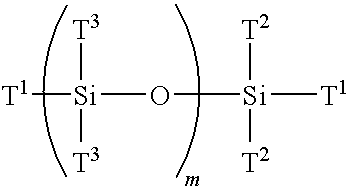Multi-armed macromonomers
a macromonomer and multi-armed technology, applied in the field of multi-armed macromonomers, can solve the problems of not being able to wear comfortably in the eye, and achieve the effects of increasing the number of polysiloxanyl macromolecules, increasing the free volume, and increasing the number of steric hindrances
- Summary
- Abstract
- Description
- Claims
- Application Information
AI Technical Summary
Benefits of technology
Problems solved by technology
Method used
Image
Examples
example 1
[0124]Preparation of 1,1,3,3-tetrachloro-1,3-dimethyldisiloxane.
[0125]To a round bottom flask equipped with a stirrer and containing dry diethylether and the acid scavenger triethylamine is added under dry nitrogen freshly distilled trichloromethylsilane. The reaction mixture is cooled to 0° C. at which time is slowly added one equivalent of distilled water. The reaction is brought to room temperature and allowed to stir for an additional hour at which time the reaction mixture is filtered and rotory evaporated to remove the solvent. The resultant oil is fractionally distilled to give the desired product. This reaction is illustrated as follows:
[0126]
example 2
[0127]Preparation of 1,3,5,7-tetrakis[N,N-bis(trimethylsilyl)aminopropyl]-1,3,5,7-tetramethylcyclotetrasiloxane (TSS).
[0128]To a round bottom flask equipped with drying tube and stirrer is added N,N-bis(trimethylsilyl)allylamine with a catalytic amount of a platinum divinyl complex (commercially available from Aldrich Chemical Company) to which is added D4′ (1,3,5,7-tetramethylcyclotetracyclotetrasiloxane) and heated to 100° C. The mixture is stirred for eight hours and the contents are vacuum distilled to give the desired product in high yield (TSS).
example 3
[0129]Preparation of N,N-bis(trimethylsilyl)aminopropyl-terminated multifunctional siloxane (AMS).
[0130]The TSS (0.96 mole) of Example 2 is added to tetrahydrofuran (THF) at room temperature containing methyl lithium (3.84 mole). The reaction mixture is stirred for two hours at which time is slowly added freshly sublimed hexamethylcyclotrisiloxane in a dry THF solution. The reaction mixture is heated to 55° C. and after two hours freshly distilled 1,1,3,3-tetrachloro-1,3-dimethyldisiloxane of Example 1 is added. The reaction mixture is stirred for one hour resulting in a multifunctional trimethylsilyl amine protected monodispersed siloxane. The amine protecting group is removed simply by heating the reaction mixture in ethanol to provide AMS. The deprotected multifunctional siloxane is devolatilized using a thin-film evaporator to remove solvent and other impurities.
PUM
| Property | Measurement | Unit |
|---|---|---|
| temperature | aaaaa | aaaaa |
| temperature | aaaaa | aaaaa |
| temperature | aaaaa | aaaaa |
Abstract
Description
Claims
Application Information
 Login to View More
Login to View More - R&D
- Intellectual Property
- Life Sciences
- Materials
- Tech Scout
- Unparalleled Data Quality
- Higher Quality Content
- 60% Fewer Hallucinations
Browse by: Latest US Patents, China's latest patents, Technical Efficacy Thesaurus, Application Domain, Technology Topic, Popular Technical Reports.
© 2025 PatSnap. All rights reserved.Legal|Privacy policy|Modern Slavery Act Transparency Statement|Sitemap|About US| Contact US: help@patsnap.com



